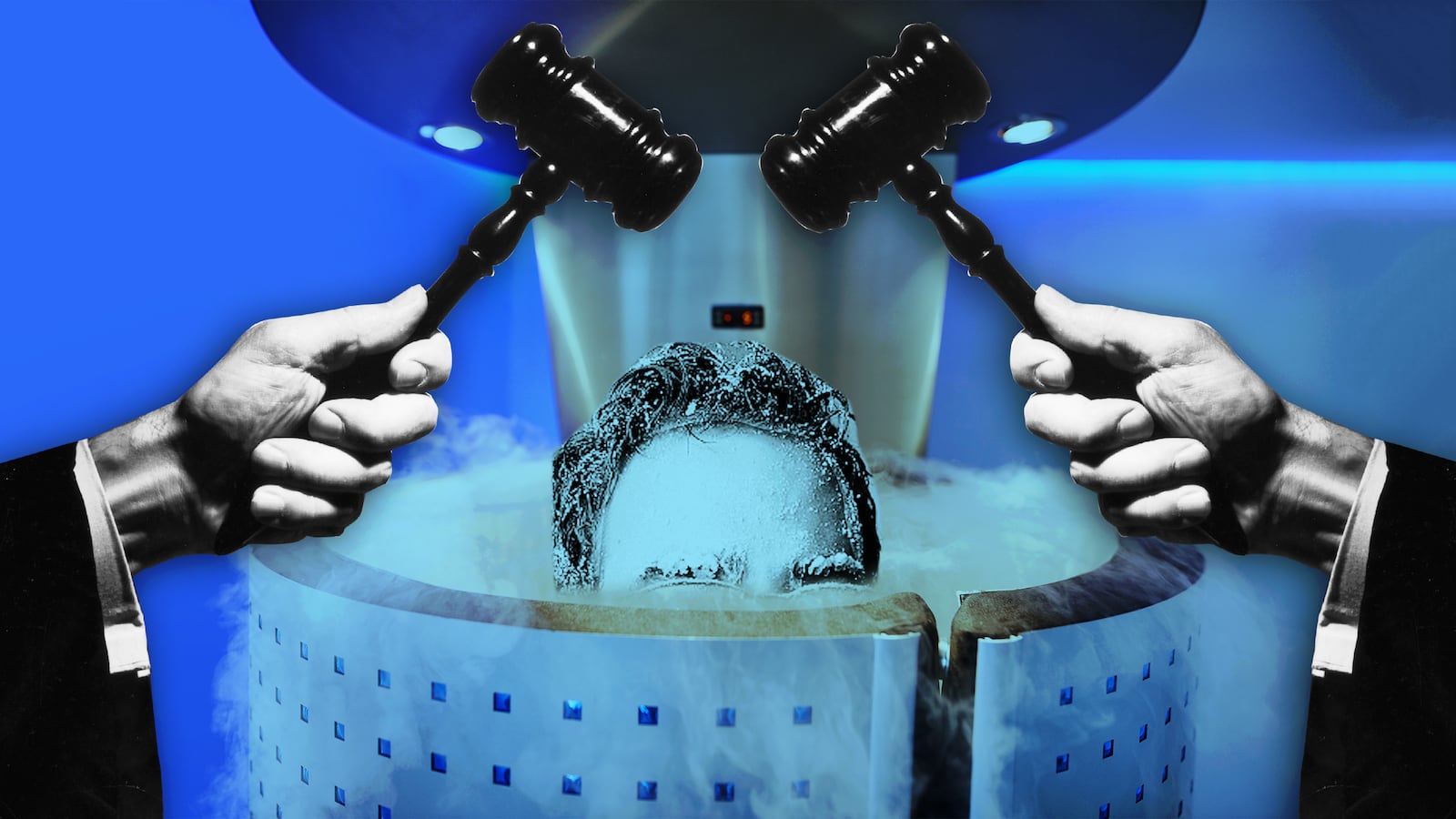About two weeks after his father died, Kurt Pilgeram opened an unexpected package. It contained his father’s cremated remains—minus the head.
Pilgeram’s father, scientist Laurence Pilgeram, collapsed on the sidewalk outside of his Goleta, California, home on April 10, 2015, and died at the age of 90. Five days later, he became the 135th patient to be cryopreserved by Alcor Life Extension Foundation, based in Arizona.
How his remains were handled by Alcor is the subject of a long-running and tangled legal dispute between the company and Pilgeram’s son, who claims that the cremation of the rest of his father’s body was a breach of contract and diminished the hopes “of bringing his head ‘back to life.’”
“Kurt is now vested in taking the matter to trial,” David J. Tappeiner, an attorney for the son, told The Daily Beast.
“Kurt has suffered extreme emotional distress as a result of Alcor's actions and has been injured as alleged in an amount in excess of $1 million,” a court filing earlier this year stated.
Alcor—which counts Boston Red Sox icon Ted Williams among its “patients”—claims on its website that it uses cryonics “to save lives by using temperatures so cold that a person beyond help by today’s medicine can be preserved for decades or centuries until a future medical technology can restore that person to full health.” (Cryonics is not the same as cryogenics, which is the branch of physics that studies the effects of very low temperatures.)
Alcor offers whole-body preservation—or head-only neuropreservation, which it says aims to “restore the patient to health by regrowing a new body around the brain using future tissue regeneration technology.”
“In the future medicine will learn to master growth and development programs within the human body,” according to Alcor. “Cells will be reprogrammed to heal severed spinal cords, regrow lost limbs, and even regenerate new organs. This kind of tissue regeneration already occurs naturally in children that lose fingertips, and in organs such as the liver.”
Using cryonics to bring someone back from the dead is, of course, not possible at the moment, and the idea is viewed with skepticism by many in the mainstream scientific community. However, advocates say new discoveries bring promise to the movement.
Despite his desire to be preserved—declared on a bracelet from Alcor—Laurence Pilgeram’s body was taken to a medical examiner’s office in Santa Barbara after his death. It stayed there until the following Monday morning “as they did not understand Alcor’s process and assumed that the circumstances surrounding his death would pre-empt any possible donation directives,” according to Alcor’s website.
Alcor claims it was not informed of the death until that Monday, when the body was released to a mortuary, where it was immediately covered in dry ice. Two of the company’s employees performed a “neuro separation” at the mortuary and then returned Pilgeram’s remains to Alcor in Arizona for “continued cool down,” which began on April 15, 2015, the site states.
Pilgeram—who had a Ph.D in biochemistry from the University of California at Berkeley—was a longtime proponent of Alcor’s cryonics program and had been giving talks at cryonics conferences since 1971.
Before his death, he took out a $100,000 insurance policy to pay for his contract fee with Alcor, according to David J. Tappeiner, the attorney who represents Kurt Pilgeram. The agreement with Alcor called for the company to “preserve his whole body,” Tappeiner told The Daily Beast on Monday.
But that’s not what happened.
Alcor froze Pilgeram’s head but cremated the rest of the “unpreserved remains without authority,” according to court papers. As a result, Karl Pilgeram and his brother Kurt, got into a dispute with Alcor over the rights to their father’s insurance money, Tappeiner said. A federal lawsuit over the matter was settled in 2015 with an agreement to place the money in escrow until the parties could agree upon how it would be disbursed, according to Tappeiner.
James Arrowood, an attorney for Alcor, would not explain to The Daily Beast why the company decided to preserve only Pilgeram’s head after his death. In a court document, Alcor stated that Pilgeram’s body was “medically unable to be preserved” but did not elaborate on what that meant.
The battle over the life insurance money wasn’t the end of it. About two years ago, the sons asked that Alcor return their father’s head to their family and release the $100,000 in escrow, according to their attorney. In response, Alcor filed a lawsuit in November 2017 in the Superior Court of California in Santa Barbara County, claiming breach of contract, among other accusations.
Pilgeram filed a counter-complaint in March in which he said Alcor sent him the box of cremated remains without warning after promising during a phone call that it would preserve his father’s entire body.
Kurt Pilgeram alleges in the legal documents he had “no idea what had happened with his father’s body until he received a package delivered to his house from a mail carrier, which purportedly contained his father’s cremated remains, except for his father’s head which was severed by Alcor and transported in a cooler to Arizona by vehicle for ‘preservation.’”
The March filing said that in his agreement with Alcor, the elder Pilgeram made clear it was his desire that the company “place into suspension any biological remains whatsoever that they may be able to recover, regardless of the severity of the damage to my human remains from such causes as fire, decomposition, autopsy, embalming, or other causes.”
The sons allege that Alcor “never intended to fulfill” the contract and that it’s “extremely unlikely” their father can be resurrected because of the number of days it took to properly preserve his body.
Kurt Pilgeram was “shocked horrified, and extremely distressed” to find that his father’s whole body had not been preserved, according to court papers.
“Alcor has engaged and continues to engage in unfair business practices by inducing elderly people to sign up for cryonic preservation under the terms of an agreement which are largely illusory,” the complaint states. “Alcor takes money from its elderly clients and then ignores its obligations under their own agreements.”
Arrowood said, in a statement to The Daily Beast: “At this time Alcor cannot specifically comment about this case but Alcor generally is confident that the legal system will properly run its course, as it has in the past.”
This is not the first time the Pilgeram family and Alcor have been in a legal skirmish.
In 1994, a California appellate court ordered Alcor to hand over the body of Laurence Pilgeram’s wife Cynthia so that she could be buried. She was cryonically frozen after she died in 1990, but her sister, Sharon Fields, later found a copy of Cynthia’s will in which she asked to be buried, according to the Associated Press.
Alcor argued that Laurence Pilgeram donated his wife’s remains based on the Anatomical Gift Act, which is usually applied to medical research or organ harvesting. But the court reportedly found that the will trumped her husband’s authority.
The next hearing on the latest case will be held in January in the Superior Court of California in Santa Barbara County, after which a trial date will likely be set.






